This post may contain affiliate links. If you use these links to buy something we may earn a commission. Thanks.
Rocky soil types require plants that don’t mind either (1) shallow pockets of soil among large rocks or (2) a lot of small to large broken rocks throughout deeper soil.
We have both of these rocky soil scenarios and grow plenty of plants in them! (Scroll to see all 36 best choices for rocky soils!)
Solutions for rock soil include:
- Find shallow-growing plants that are suitable for rocky areas
- Re-arrange or stack rock and add soil to grow deeper-rooted desired plants
- Grow plants that don’t mind deep soil full of assorted rocks
- Dig up the rocks and set them aside for above-ground projects
Related: 21 Tasty Herbs That Grow Well in Rocky Soil

If you have shallow soil pockets of soil in larger rocks, you’ll find plenty of ground cover options (soon in this post) that will help hold together and build the soil over time. Look for “suitable for shallow soil” in the description if this is the area you need plants for.
If you have a lot of assorted rock in a lot of soil, your options are far less limited. Rocky deep soils are mineral-rich places to grow nutritious food or healthy plants. Having rocks in the soil is better than having no rocks in the soil. Without them, you’re missing out on a fortune of potential advantages!
Rocks in the soil can be dug out, put aside, and used for landscaping design and borders, thermal mass for micro-climate making, to deter deer from entering your site, and more.
For landscaping, rocks make beautiful borders between beds and paths and it only costs you the time to dig them out, throw them aside, and stack them. Stacking can be a slow but tranquil experience.
Bookmark this page till next spring or fall so you can revisit and put together an order for plants.
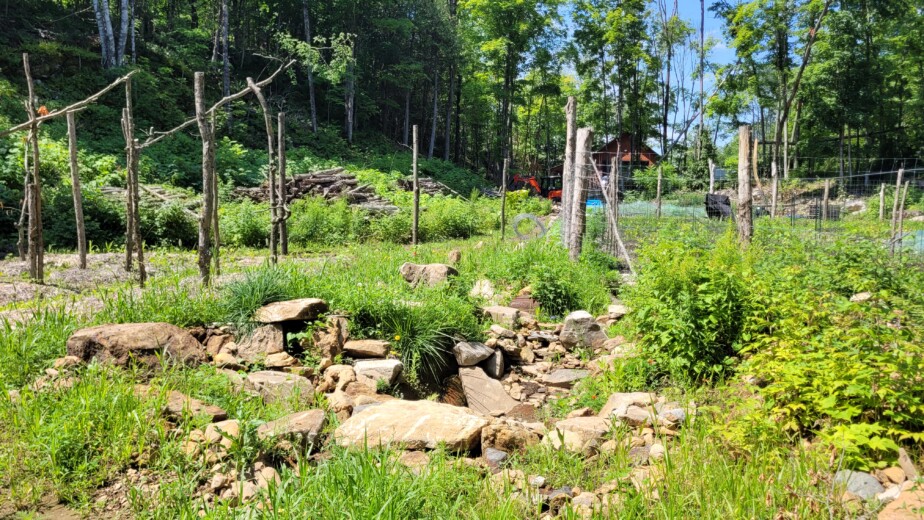
For thermal mass and micro-climate benefits, rocks used as a border, for example, heat up from exposure to the sun.
Matt Powers explained a brilliant idea—he said he was going to try getting a mushroom harvest sooner in the season by using the heat of rocks.
He mentioned in his video burying his rock border with his wine cap mushroom inoculated wood chips, and then adding more rock on top of the border.
His idea is that the conduction between the rocks on the top would transfer heat down into the underground rocks and render enough warmth to extend the mushroom harvest season compared to non-rock areas.
For deterring deer, loads of small rocks can act like a “cattle grid.” They prefer not to walk on unstable surfaces.
But if you aren’t looking for the labor of digging up and handling an endless supply of rocks, you have plenty of ground cover choices!
Disclaimer: Food Forest Living or its authors are not responsible for what you choose to consume. Do your own research before consuming anything “edible” or “medicinal.” Before planting any of these options check with your local invasive plant council or regional extension office for guidance on plants that may be invasive in your area.
What are the best ground covers for rocky soil?
For shallow rocky soils, drought-tolerant creepers are excellent since they vine above the ground and root easily into nooks, crannies, and crevices.
Bonus: Mushrooms! With a layer of wood chips and/or straw, edible mushrooms will grow! But you don’t want just any mushrooms, you want gourmet edible or medicinal kinds, see: Grow a Mushroom Garden at Home in 4 Steps. Winecaps can grow in sun or shade, but other species are best set in bright light with shade or dappled shade.
Creeping sedums
Creeping sedums are a practical and showy choice, especially for sunny rocky gardens.
Some low-growing choices include:
- Coral Reef Chinese Sedum (Sedum tetractinum) zones 5-8
- White Sedum (Sedum album) zones 3-9
- Japanese Stonecrop (Hylotelephium sieboldii) zones 3-9
- Angelina Stonecrop (Sedum rupestre) zones 3-9
- Lime zinger zones 4-9
They all grow between 2-6 inches in height, take full sun conditions, and thrive on watering neglect.
See what sedums are available to order online from Nature Hills Nursery’s sedum selection.
Suitable for shallow soil
Several other trailing plants that aren’t succulent are also adapted to rocky conditions. Evergreens, edibles, flowers, and more.
Trailing Bellflower (Campanula poscharskyana)
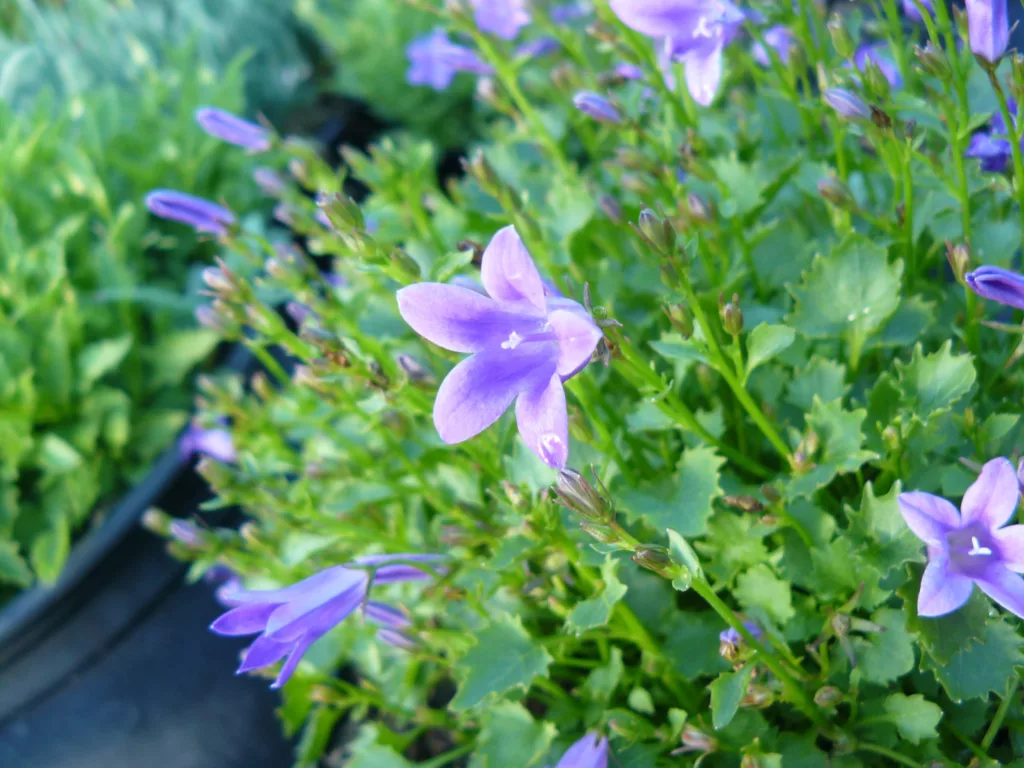
- Native to Europe
- Zones 3-7
- Edible with pretty purple flowers, ground cover
- 1-foot height and fast-growing
- Semi-shade to full sun
- Photo and more information
- Suitable for shallow soil
See all the types of campanula you can get here.
Chaparral Broom (Baccharis pilularis)

- Native to North America
- Zones 8-10
- Stabilizes all soil types
- 1-2 foot height and fast-growing
- Full sun
Downy wood mint (Blephilia ciliata)
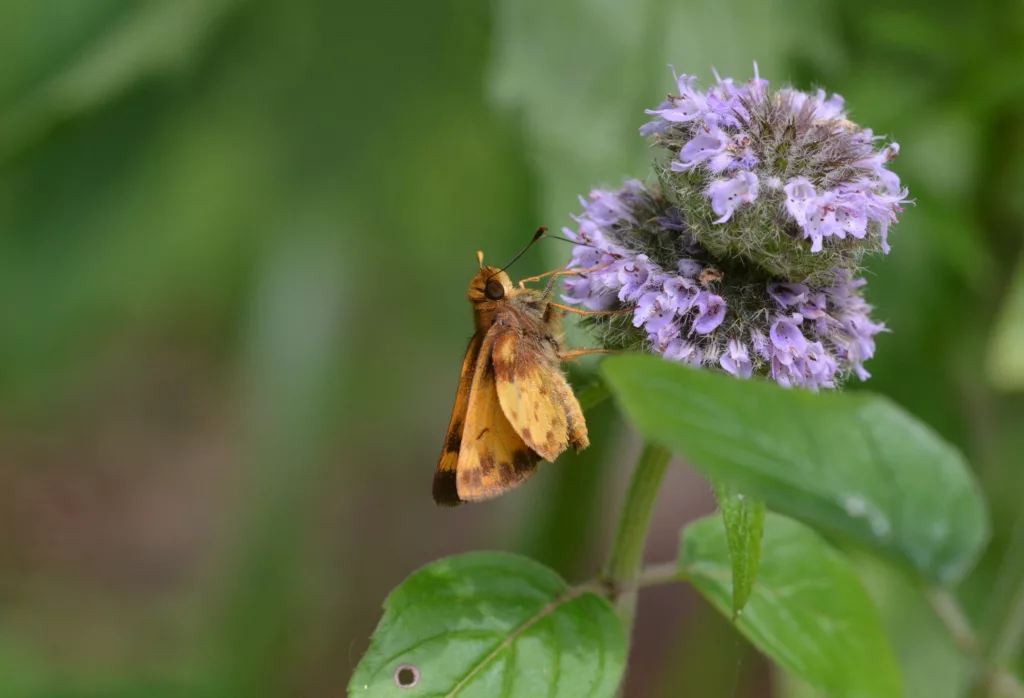
Downy wood mint is an excellent choice for about everything—It’s native to North America, the local pollinators love it, and so do we! It’s fragrant and has nice lavender-purple flowers. With a less aggressive spreading nature than other mints, it makes a good ground cover that won’t get out of hand.
Its tolerance to drought makes it suitable for rocky conditions. It grows and fills in fast and is very easy to grow from seed. Seeds are available here.
If you love mint tea, mid-summer is the prime time to cut back a few stems for harvesting a supply of leaves.
- Zones 4-7
- 2-foot height and fast-growing
- Part shade to full sun
Related: 12 Low-Growing (Low Maintenance) Edible Ground Covers
Blue leadwood (Ceratostigma plumbaginoides)
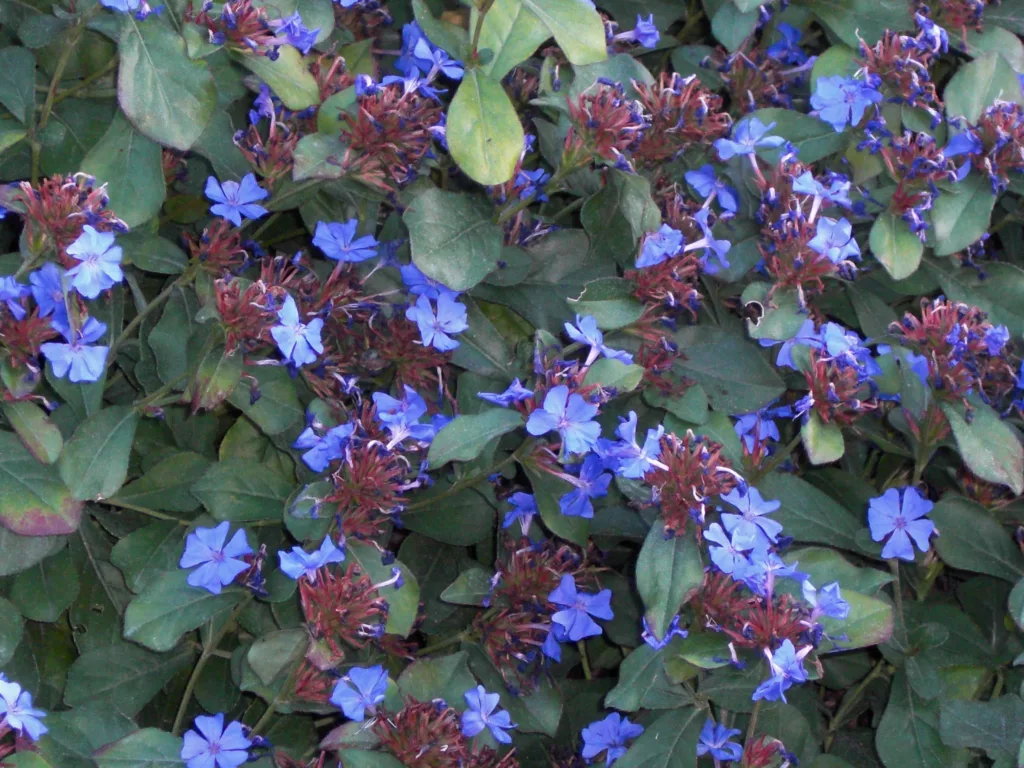
- Native to Asia
- Zones 6-9
- Blue flowers, erosion controller, ground cover
- 1-2 foot height and fast-growing
- Full sun
- Suitable for shallow soil
Whorled tickseed (Coreopsis verticillata)
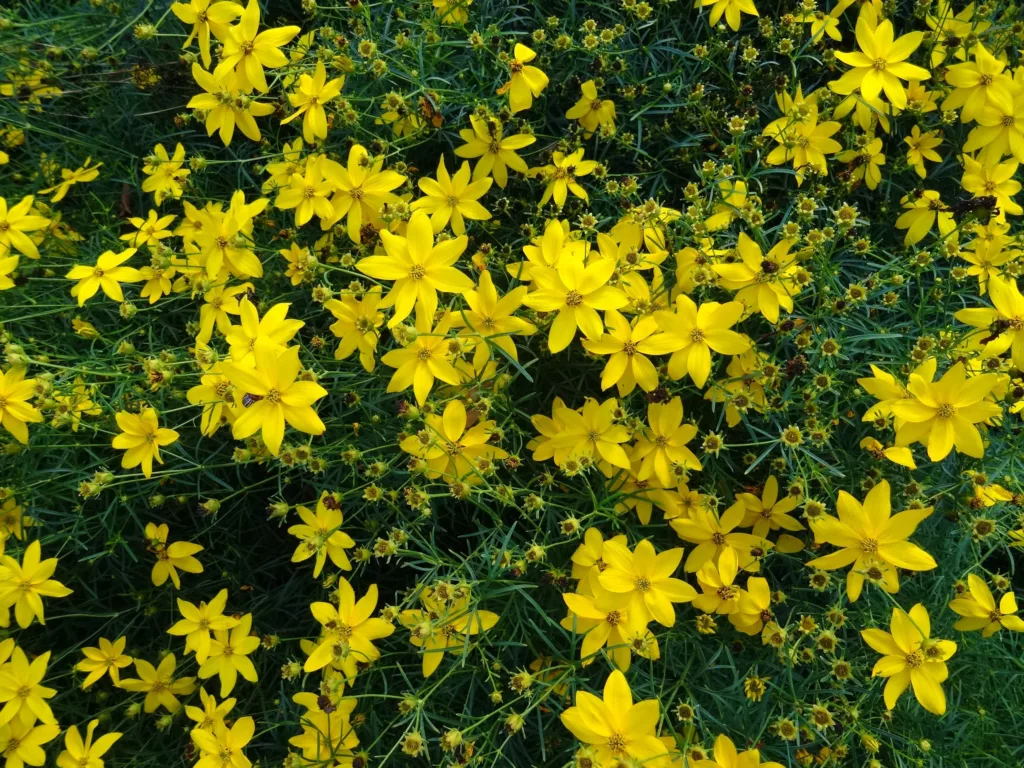
This gorgeous (and native) ground cover comes with yellow, bright yellow, or peach flowers that bloom all season long—see what’s available here. Both local pollinator and neighbor friendly.
Coreopsis is useful for controlling erosion—they grow fast, have good roots, and protect the soil with dense bushy coverage—perfect for rocky areas.
- Native to North America
- Zones 3-9
- 3-foot height and fast-growing
- Full sun
Moss phlox (Phlox subulata)
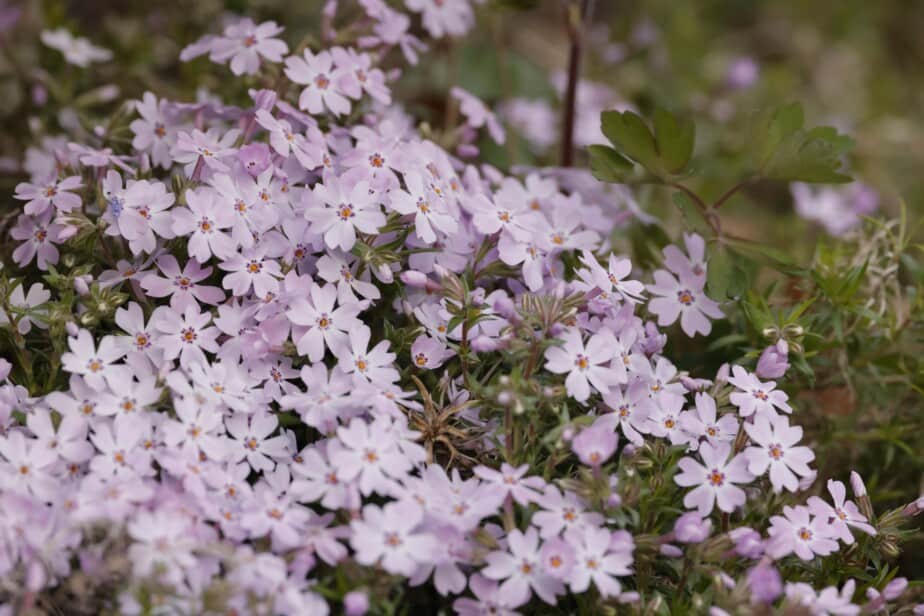
Not many dislike phlox. Moss phlox is a lower-growing variety that sprawls and mats. Other phlox varieties are small upright and rounded bushes.
Phlox offers a wide variety of flower colors!
- Native to North America
- Zones 4-9
- Evergreen, erosion control, ground cover, and wildlife-attracting flowers
- 4-inch height and fast-growing
- Full sun
Tropical Kudzu (Pueraria phaseoloides)
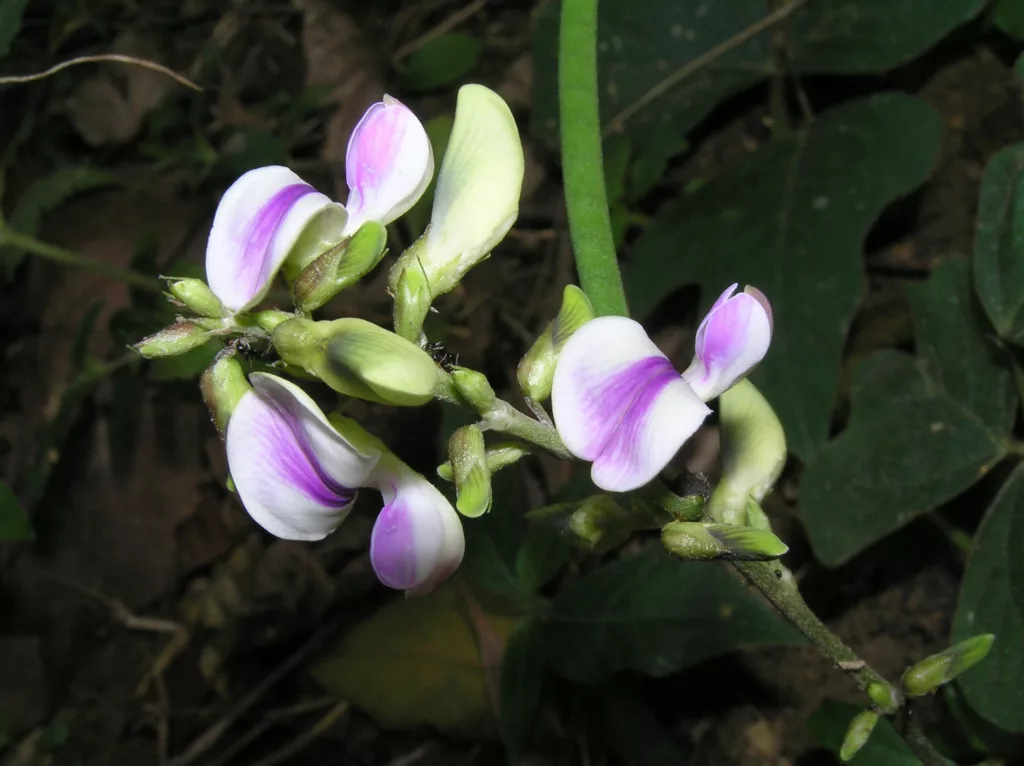
Not recommended to plant outside its native range. This fast-growing nitrogen fixer can become invasive to native species.
But if you live in Asia, consider this as an edible and nitrogen-fixing ground cover!
- Native to Asia
- Zones 10-12
- Edible roots, a nitrogen fixer, soil stabilizer and reclaimed, and used as ground cover or climber
- Fast-growing climbing vine
- Full sun
Wild Ginger (Asarum caudatum)
- Native to North America
- Zones 6-10
- Edible, medicinal, ground cover
- 4-inch height and fast-growing
- Full shade to partial shade
Mottled wild ginger (photo and more info) is similar but for zones 5-9. Snakeroot is also similar but for zones 3-9.
Potentilla (Potentilla fruticosa)
- Native range Europe and Asia
- Zones 2-6
- Edible foliage for tea, has yellow flowers, soil stabilizer, windbreak hedge, and ground cover
- 4-foot shrub with a medium-growth rate
- Semi-shade to full sun
Bearberry (Arctostaphylos uva-ursi)
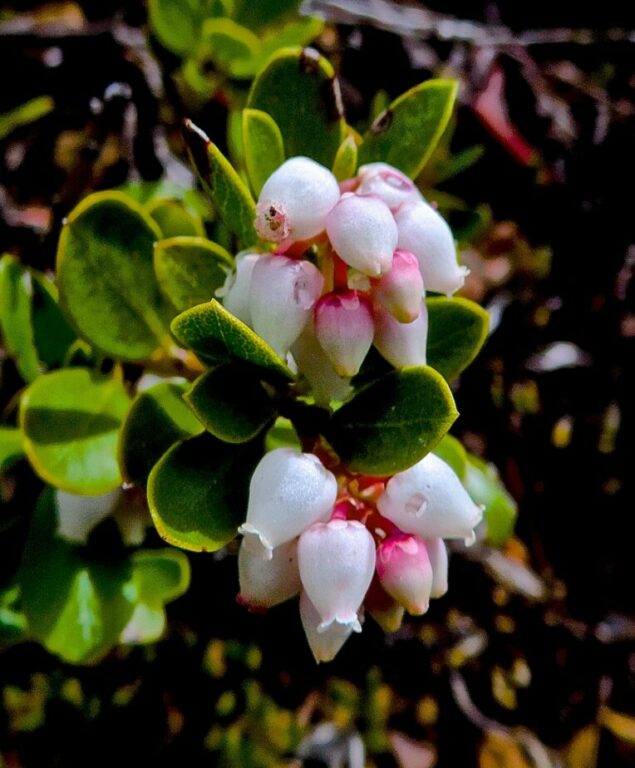
- Native range is Britain, Europe, North America, and Asia
- Zones 4-8
- Edible fruit and foliage, medicinal, ground cover, soil stabilizer, and soil reclaimer
- 4-inch height and fast-growing
- Full shade to full sun
Related: 19 Tasty Fruiting (Low-Growing) Ground Covers
Bayonet bromeliad (Bromelia serra)
- Native to South America
- Zones 10-12
- Edible shoots and fruit, ground cover, or hedge
- 1-2 foot height and fast-growing
- Full shade to full sun
Adria Bellflower (Campanula portenschlagiana)
- Native to Europe
- Zones 3-7
- Evergreen, very flowery, attractive to pollinators, edible flowers and leaves, and ground cover
- 1-foot height and fast-growing
- Partial shade to full sun
Trumpet Creeper (Campsis grandiflora)
- Native to Asia
- Zones 6-9
- Fast-growing climbing or trailing vine
- Ground cover
- Partial sun or full sun
Green and Gold (Chrysogonum virginianum)
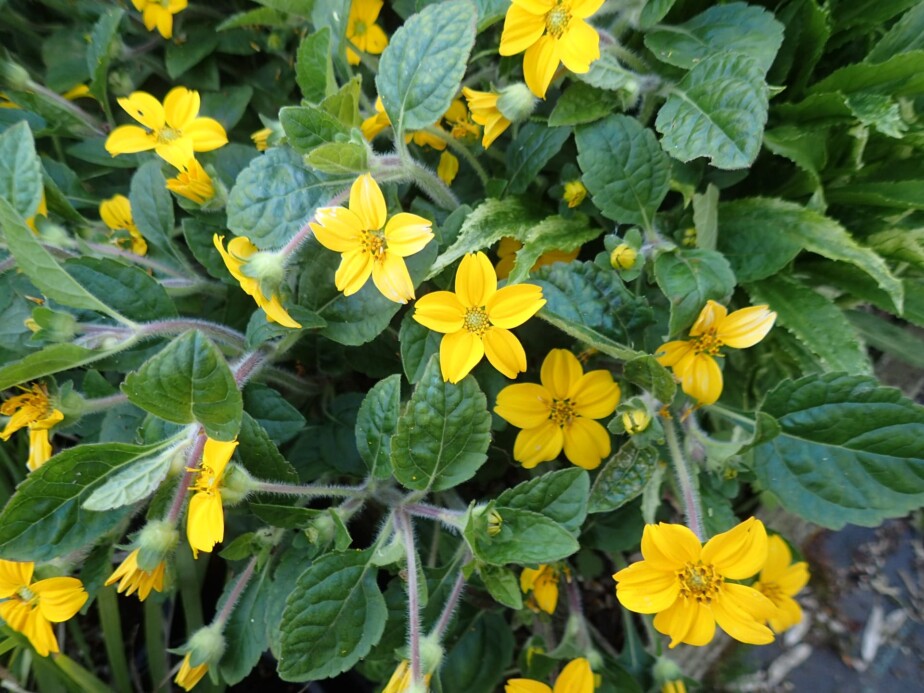
- Native to North America
- Zones 5-9
- Evergreen, attracts wildlife and pollinators, yellow flowers, and ground cover
- 8-inch height and fast-growing
- Full shade to full sun
Pink tickseed (Coreopsis rosea)
- Native to North America
- Zones 5-9
- Attracts birds and pollinators
- 2-foot height and fast-growing
- Part shade or full sun
Creeping Dogwood (Cornus canadensis)
- Native to North America
- Zones 2-7
- Edible fruit, pectin source, medicinal, attracts birds, and ground cover
- 1-foot height and fast-growing
- Partial shade or full sun
Related: 27 Easy Ground Covers For Clay Soil (Sorted Choices)
Ferns (Dennstaedtia punctilobula)
- This fern is native to North America
- Zones 3-8
- Evergreen, ground cover, attractive foliage, pop of color and texture
- 2-foot height and fast-growing
- Partial shade to full shade
Strawberries
- Native range from North and South America, Europe, and Asia
- Zones 5-10
- Edible, ground cover
- 8-inch height and fast-growing
- Partial shade to full sun
Robin’s plantain (Erigeron pulchellus)
- Native to North America
- Zones 4-8
- Ground cover, pollinator attractor with lots of nectar to offer
- 2-foot height and fast-growing
- Partial shade to full sun
Blanket flower (Gaillardia x grandiflora)
- Native to North America
- Zones 3-10
- Edible leaves, and showy flowers, attracts wildlife, and ground cover
- 1-foot height and fast-growing
- Full sun
Bigroot Geranium (Geranium macrorrhizum)
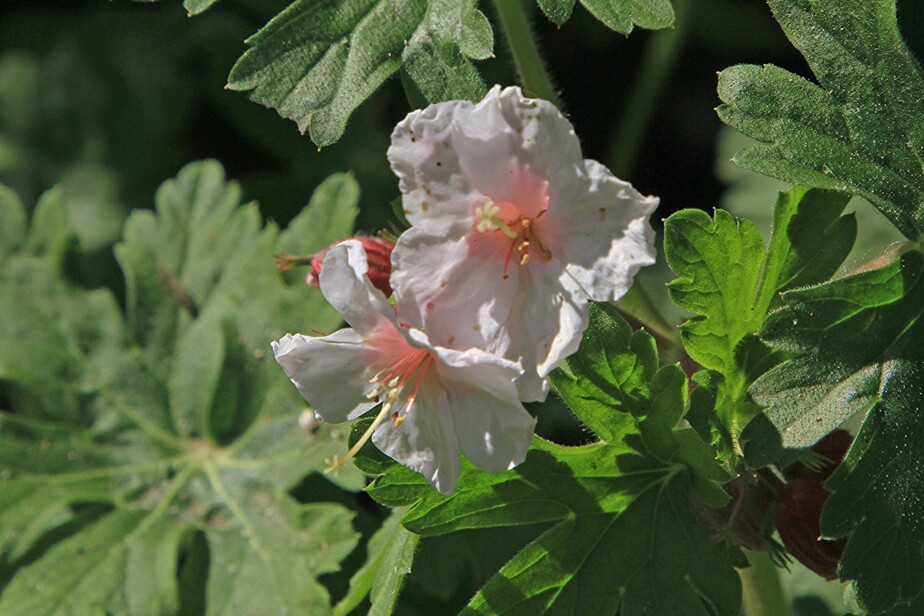
- Native to Europe
- Zones 4-8
- Fragrant and showy foliage and flowers, ground cover
- 1-2 foot height and fast-growing
- Full shade to full sun
Common Rockrose (Helianthemum nummularium)
- Native to Europe and Asia
- Zones 5-18
- Ground cover, short-lived
- 1-2 foot height and fast-growing
- Partial shade to full sun
Alum Root (Heuchera micrantha)
- Native to North America
- Zones 4-8
- Edible leaves, evergreen, ground cover
- 2-foot height
- Partial-shade or full sun
Azure bluet (Houstonia caerulea)
- Native to North America
- Zones 3-8
- Edible flowers and leaves, attracts pollinators, and ground cover
- 4-inch height and fast-growing
- Partial shade to full sun
Hydrangea (Hydrangea anomala)
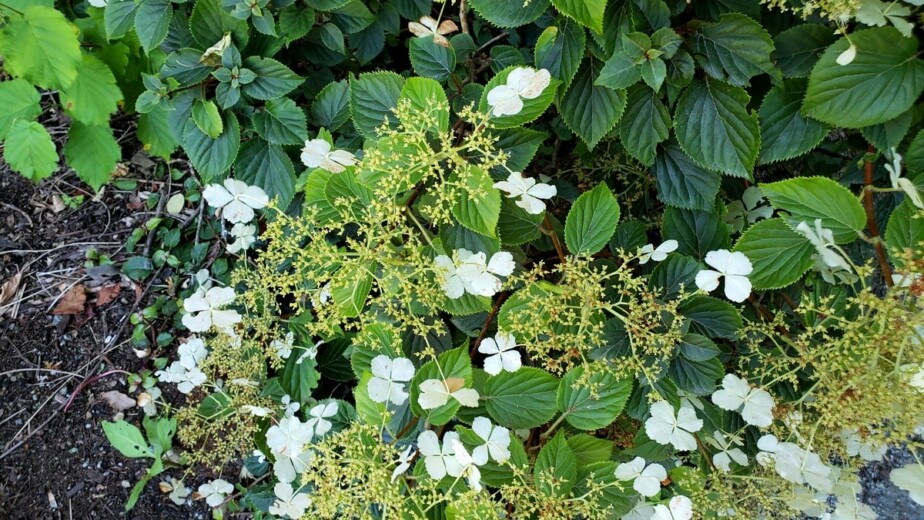
This article was originally published on foodforestliving.com. If it is now published on any other site, it was done without permission from the copyright owner.
- Native to Asia
- Zones 4-8
- Edible leaves and sap, showy flowers, and attracts pollinators
- Fast-growing climbing vine
- Full shade to full sun
Related: Best Bee-Friendly Plants For Clay Soil Improvement
Tutsan (Hypericum androsaemum)
- Native to Europe and Asia
- Zones 5-10
- Fragrant ground cover
- 3-foot height and fast-growing
- Partial shade to full sun
Creeping Jenny (Lysimachia nummularia)
- Native to Europe
- Zones 4-8
- Evergreen, edible for tea, and ground cover
- 8-inch height and fast-growing
- Partial shade to full sun
Wood Sorrel (Oxalis acetosella)
- Native to Europe and Asia
- Zones 3-7
- Ground cover, edible, and medicinal
- 4-inch height and fast-growing
- Full shade to full sun
Virginia Creeper (Parthenocissus quinquefolia)
- Native to North America
- Zones 3-10
- Edible fruit, root, and stems, and medicinal11 Best Zone 4 & 5 Ground Covers for Shade (with Photos)
- Fast-growing climber
- Partial shade full sun
Fountain Grass (Pennisetum alopecuroides)
- Native to Asia
- Zones 5-9
- Edible seed, and ground cover
- 5-foot height and fast-growing
- Partial shade to full sun
Maidenhair Fern (Polypodium vulgare)
- Native to Europe, Asia, and North America
- Zones 3-6
- Edible root, medicinal, rich in potash, and ground cover
- 1-foot height and fast-growing
- Partial shade to full shade
Related: 11 Best Zone 4 & 5 Ground Covers for Shade (with Photos)
Memorial Rosa (Rosa wichuraiana)
- Native to Asia
- Zones 5-8
- Edible fruit and leaves, attracts pollinators, fragrant, and ground cover
- Grows up to 16 feet and is fast-growing
- Partial shade or full sun
Up next: 13 Best Ground Covers for Erosion & Slopes (Zone 5)
Recent Posts
There’s no shortage of full-sun ground covers for zone 4 climates! Each plant in this list can withstand the frigid temperatures and also enjoy the hot sun in summer. Full sun means that a plant...
There's no shortage of full sun ground covers, not even in zone 3! Zone 3 climates offer hot but short-lived summers and very cold winters. So each plant in this list can withstand the frigid...
